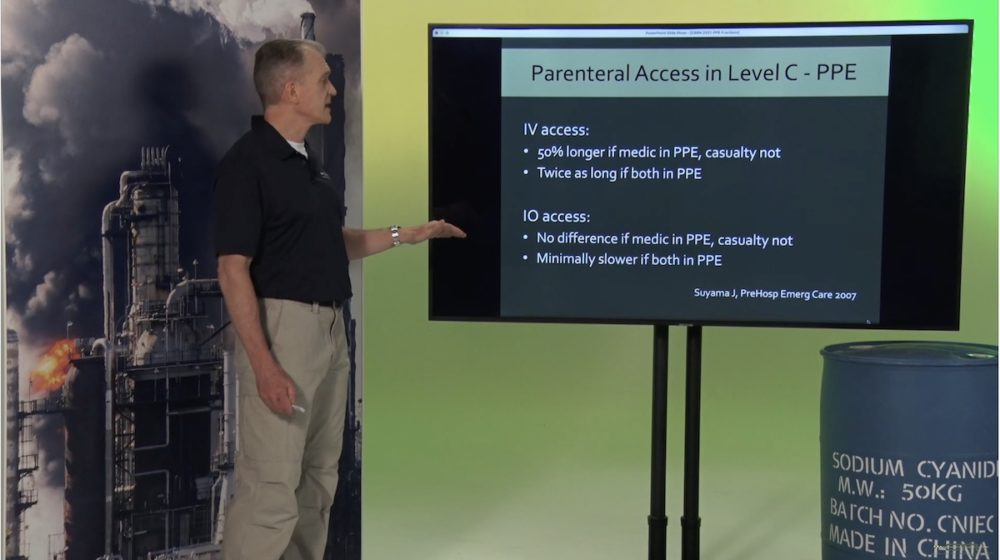
Best Parenteral Access in a CBRN Environment?
- Posted by Mike Shertz MD/18D
- Categories Tactical CBRN
🕖 Reading Time, 6 minutes
When providing medical treatment to CBRN casualties, to save lives, initial treatment will need to be conducted before formal decontamination can be completed. These procedures, performed in a “dirty casualty collection point,” will require the medical provider themselves to still be in CBRN appropriate PPE.
While atropine/pralidoxime auto-injectors exist for treatment of the nerve agent casualty, severely nerve agent poisoned individuals will need additional atropine dosing requiring either an enormous quantity of single drug auto-injectors or multi-dose vials of atropine. In experimental animal models, hypotensive animals who were also nerve agent poisoned atropine administered via IM auto-injectors took 19.5 minutes to reach maximum serum concentration. The same dose administered IV / IO reached maximum serum concentration nearly instantaneously1 Midazolam, the best benzodiazepine to control nerve agent-induced seizures, reaches peak concentration in 2 minutes given IV / IO, but a full 10 minutes when administered IM.2
For many chemical warfare agents, like cyanide, no intramuscular antidotes are readily available, and treatment will require parenteral access. This requires either intravenous or intraosseous access.
Wearing butyl rubber gloves alone has been shown to degrade hand dexterity by 30 to 40%.3 A study of 64 providers looking specifically at their ability to start IVs while wearing level C PPE showed it took two to three times longer and was 10-15% less successful compared to the same placement without level C PPE.4 IO access, also studied in the same experiment, showed only a 50% increase in the duration of the procedure using an EZ-IO drill, but no decreased successful placement by providers wearing level C PPE. On average, IO access was accomplished 90 seconds faster than IV. Another similar study utilizing 22 paramedic students compared IV placement to EZ-IO access showed very similar results favoring IO access.5 A study of 36 Italian senior Emergency Medicine and Anesthesia residents in level C CBRN PPE showed slower IV and IO placement times compared to no PPE. This was one of the few studies showing similar delays in both procedures, but the authors specifically acknowledge IO was faster than IV while wearing PPE.6
What does all this mean for the first responder caring for CBRN casualties in a dirty CCP? IO access is the preferred form of parenteral access and has been best studied using the EZ-IO.
1Yost J, Baldwin P, Bellenger S, Bradshaw F, Causapin E, Demotica R, Livingston M, Lee C, Gegel B, Burgert J, Claessens A, Johnson D, Loughren M. The pharmacokinetics of intraosseous atropine in hypovolemic swine. Am J Disaster Med. 2015 Autumn;10(3):217-22.
2Eisenkraft A, Gilat E, Chapman S, Baranes S, Egoz I, Levy A. Efficacy of the bone injection gun in the treatment of organophosphate poisoning. Biopharm Drug Dispos. 2007 Apr;28(3):145-50.
3Krueger GP. Psychological and performance effects of chemical-biological protective clothing and equipment. Mil Med. 2001 Dec;166(12 Suppl):41-3.
4Castle N, Owen R, Hann M, Clark S, Reeves D, Gurney I. Impact of chemical, biological, radiation, and nuclear personal protective equipment on the performance of low- and high-dexterity airway and vascular access skills. Resuscitation. 2009 Nov;80(11):1290-5.
5Suyama J, Knutsen CC, Northington WE, Hahn M, Hostler D. IO versus IV access while wearing personal protective equipment in a HazMat scenario. Prehosp Emerg Care. 2007 Oct-Dec;11(4):467-72.
6Mormando G, Paganini M, Alexopoulos C, Savino S, Bortoli N, Pomiato D, Graziano A, Navalesi P, Fabris F. Life-Saving Procedures Performed While Wearing CBRNe Personal Protective Equipment: A Mannequin Randomized Trial. Simul Healthc. 2021 Dec 1;16(6):e200-e205.
Dr. Mike Shertz is the Owner and Lead Instructor at Crisis Medicine. Dr. Shertz is a dual-boarded Emergency Medicine and EMS physician, having spent over 30 years gaining the experience and insight to create and provide his comprehensive, science-informed, training to better prepare everyday citizens, law enforcement, EMS, and the military to manage casualties and wounded in high-risk environments. Drawing on his prior experience as an Army Special Forces medic (18D), two decades as an armed, embedded tactical medic on a regional SWAT team, and as a Fire Service and EMS medical director.
Using a combination of current and historical events, Dr. Shertz’s lectures include relevant, illustrative photos, as well as hands-on demonstrations to demystify the how, why, when to use each emergency medical procedure you need to become a Force Multiplier for Good.





